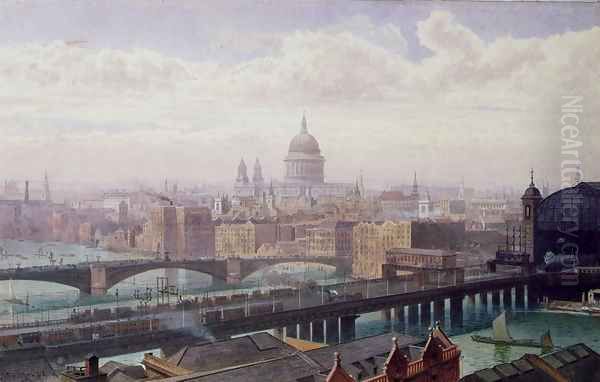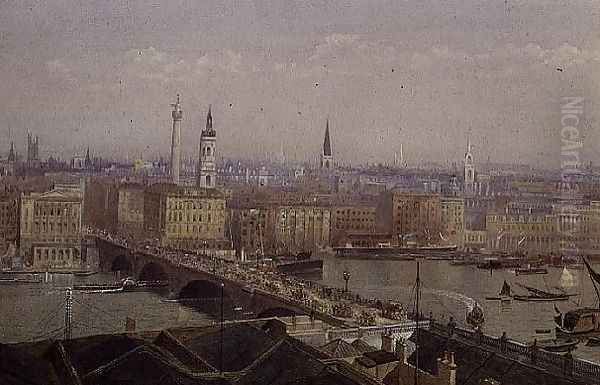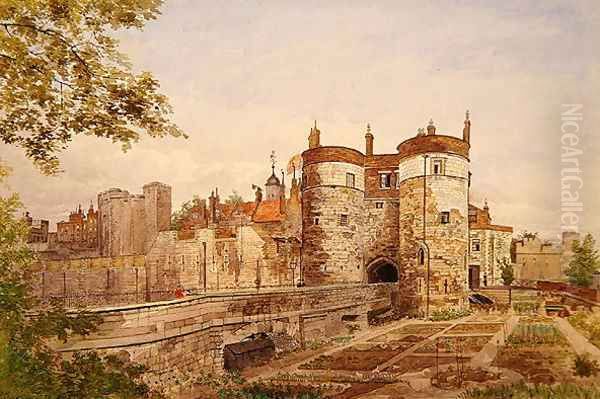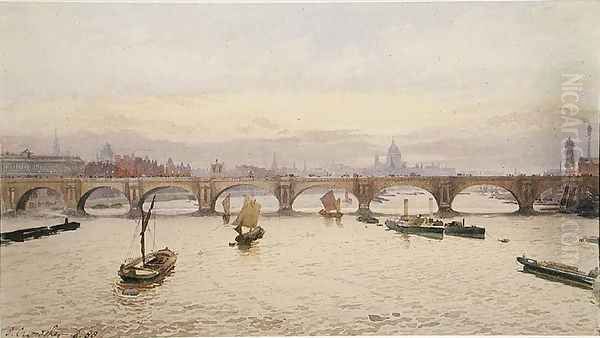The annals of art history are replete with figures whose contributions, though significant, may not always occupy the most prominent positions in popular discourse. John Crowther (1837-1902) is one such artist, a painter whose work offers a fascinating window into the heart of Victorian London. While biographical details about Crowther the painter remain somewhat elusive, his art, particularly his depictions of the sprawling metropolis, speaks volumes. His canvases capture the unique atmosphere, architectural grandeur, and burgeoning modernity of London during a period of profound transformation. To understand Crowther is to delve into the very essence of the Victorian age, its aspirations, its anxieties, and its undeniable visual drama.
The Artist in His Time: Victorian London's Crucible
John Crowther lived and worked during a period of unprecedented change in Britain. The Victorian era, spanning Queen Victoria's reign from 1837 to 1901, was characterized by industrial revolution, imperial expansion, scientific advancement, and significant social upheaval. London, as the heart of the British Empire and a global hub of commerce and industry, was at the epicenter of this transformation. Its population boomed, its infrastructure strained and expanded, and its skyline was dramatically altered by new feats of engineering and architecture.
This dynamic environment provided fertile ground for artists. The city itself became a compelling subject, offering a rich tapestry of human experience, architectural marvels, and atmospheric effects. From the bustling docks along the Thames to the newly constructed railway termini, from the grand public buildings to the fog-laden streets, London was a city of contrasts and endless visual stimuli. Artists of the period responded in diverse ways, some celebrating its progress, others critiquing its social ills, and many, like Crowther, seeking to capture its distinctive character and mood.

The artistic landscape of Victorian Britain was equally diverse. The Royal Academy of Arts held considerable sway, championing traditional history painting, portraiture, and genre scenes. However, new movements and ideas were also emerging. The Pre-Raphaelite Brotherhood, founded in 1848 by artists like William Holman Hunt, John Everett Millais, and Dante Gabriel Rossetti, challenged academic conventions with their emphasis on detailed realism and subjects drawn from literature and modern life. Later in the century, the influence of French Impressionism, with its focus on capturing fleeting moments and the effects of light and atmosphere, began to be felt, though its reception in Britain was initially mixed. Artists like James Abbott McNeill Whistler, an American expatriate working in London, developed a unique aesthetic approach, particularly in his atmospheric "Nocturnes" of the Thames, which resonated with the city's often misty and ethereal quality.
Crowther's Masterpiece: "View of London"
The cornerstone of our understanding of John Crowther's artistic contribution is his painting "View of London," reportedly created in the 1880s. This work depicts a panoramic vista featuring St. Paul's Cathedral and Cannon Street Station as seen from Southwark Bridge. Such a vantage point was popular among artists, offering a sweeping view that encompassed both historic landmarks and symbols of modern progress.
St. Paul's Cathedral, Sir Christopher Wren's baroque masterpiece, had long been an iconic symbol of London's resilience and spiritual heart. Its majestic dome dominated the skyline and served as a visual anchor in countless depictions of the city. Juxtaposed with this historic edifice is Cannon Street Station, a relatively new structure at the time, having opened in 1866. Railway stations were potent symbols of the industrial age, representing technological prowess, the acceleration of travel and commerce, and the increasing interconnectedness of the nation. The inclusion of both these structures in Crowther's composition highlights the dialogue between London's rich past and its dynamic present.
The painting is noted for its depiction of the "Great Smoke," or "London Fog" – the notorious smog that frequently enveloped the city, a byproduct of coal-burning factories and domestic hearths. This atmospheric condition, while a serious environmental concern, lent a unique visual character to London, softening outlines, muting colors, and creating a sense of mystery and drama. Artists like Claude Monet, who famously painted series of London scenes including the Houses of Parliament and Charing Cross Bridge in the late 19th and early 20th centuries, were particularly drawn to these effects. While Monet's approach was distinctly Impressionistic, focusing on the subjective experience of light and color, Crowther's style, as described, seems to have leaned towards a more detailed, topographical rendering, albeit one highly sensitive to atmospheric conditions.
Artistic Style and Technical Approach

John Crowther's artistic style, based on descriptions of "View of London," appears to be rooted in the tradition of detailed urban landscape painting. This genre had a long history in Britain, with artists meticulously recording the architectural features and daily life of cities. In the Victorian era, this tradition continued, often infused with a sense of civic pride or a desire to document a rapidly changing environment.
Crowther's commitment to capturing rich detail suggests an affinity with the Victorian penchant for verisimilitude. His works would have aimed to provide an accurate and recognizable portrayal of the London cityscape. This attention to detail would have extended to the architectural nuances of buildings like St. Paul's and Cannon Street Station, as well as the myriad of smaller elements that constitute a bustling urban scene – the flow of traffic on the bridge, the boats on the Thames, and the general hum of city life.
However, his work was not merely a dry, topographical record. The emphasis on capturing light and shadow, and the pervasive presence of the London fog, indicates a keen interest in atmospheric effects. This aligns him with a broader artistic concern of the period: how to represent the intangible qualities of light, air, and weather. While his technique may have differed from the broken brushwork and optical color mixing of the French Impressionists or even British interpreters like Philip Wilson Steer or Walter Sickert (who became prominent later), Crowther shared their fascination with the interplay of light and atmosphere in shaping the visual experience of the city.
His approach might be compared to that of other Victorian painters of London, such as John O'Connor, known for his detailed and atmospheric cityscapes, or George Vicat Cole, who, though primarily a landscape painter, also captured views of the Thames. The Italian-born artist Giuseppe De Nittis, who spent time in London, also produced evocative urban scenes that balanced detail with atmospheric sensitivity. Crowther's work would have contributed to this ongoing artistic conversation about how best to portray the modern metropolis.
London as Subject: A City of Contrasts
For an artist like John Crowther, London in the 1880s offered an inexhaustible supply of subject matter. The decade was a period of continued growth and significant events. The city was a place of immense wealth and grinding poverty, of grand imperial displays and pressing social problems. This inherent duality was often reflected in the art of the time.

Artists like Luke Fildes, with his powerful social realist painting "Applicants for Admission to a Casual Ward" (1874), or Hubert von Herkomer, in works like "Hard Times" (1885), confronted the harsher realities of urban life. While Crowther's "View of London" seems to focus more on the architectural and atmospheric grandeur of the city, the social context would have been an unavoidable backdrop. The "Great Smoke" itself was a testament to the industrial activity that fueled the city's economy but also contributed to its environmental challenges and impacted the health of its inhabitants.
The Thames, a central feature in Crowther's known work, was London's lifeblood. It was a working river, crowded with barges, steamers, and sailing ships, its banks lined with warehouses, wharves, and factories. Artists had long been captivated by the river's moods and its central role in the city's identity. J.M.W. Turner, though from an earlier generation, had set a precedent with his sublime and atmospheric depictions of the Thames, influencing generations of painters. Whistler's aforementioned "Nocturnes" offered a more poetic and abstracted vision of the river at night. Crowther's depiction, by contrast, likely presented a daytime view, bustling with activity, yet softened and unified by the pervasive atmosphere.
The development of the railways, symbolized by Cannon Street Station in Crowther's painting, was another key theme for Victorian artists. William Powell Frith's "The Railway Station" (1862) is a celebrated example, a sprawling canvas teeming with diverse characters and narratives, capturing the social microcosm of the modern transport hub. While Crowther's focus was on the station as an architectural element within a broader cityscape, its inclusion speaks to the profound impact of rail travel on Victorian society and its visual landscape.
Crowther in the Context of His Contemporaries
Placing John Crowther within the broader artistic milieu of the 1880s requires considering the diverse currents shaping British art. The Royal Academy, under presidents like Frederic Leighton and later John Everett Millais (one of the original Pre-Raphaelites who had by then become a pillar of the establishment), continued to promote a certain standard of academic excellence. Grand history paintings, mythological scenes by artists like Leighton or Lawrence Alma-Tadema (known for his meticulous depictions of classical antiquity), and society portraits by figures such as John Singer Sargent (though his major impact in London was slightly later) were highly regarded.
Alongside this, landscape and seascape painting remained popular, with artists like Benjamin Williams Leader producing picturesque views that appealed to Victorian tastes. The influence of the Aesthetic Movement, which emphasized "art for art's sake" and the pursuit of beauty, was also palpable, championed by figures like Whistler and influencing decorative arts as well as painting.

Crowther's specific niche appears to have been the detailed and atmospheric urban landscape. In this, he shared common ground with artists who specialized in topographical views but also sought to imbue them with a sense of mood and character. The challenge for such artists was to balance accuracy with artistic expression, to create a convincing representation of a place that also resonated emotionally with the viewer.
The 1880s also saw the rise of new exhibition venues and societies, offering alternatives to the Royal Academy. The Grosvenor Gallery, for instance, provided a platform for artists associated with the Aesthetic Movement. The New English Art Club (NEAC), founded in 1886, became a forum for artists influenced by French naturalism and Impressionism, including figures like George Clausen and Walter Sickert. It is unclear whether Crowther was associated with any of these groups, or if he primarily exhibited at the Royal Academy or other established venues. His relative obscurity today might suggest a more independent path or a career that, for various reasons, did not achieve lasting widespread fame.
The Enduring Appeal of Victorian London Scenes
Paintings of Victorian London, like John Crowther's "View of London," continue to hold a strong appeal for contemporary audiences. They offer a glimpse into a world that is at once familiar and strikingly different. The landmarks may still stand, but the city's atmosphere, its social fabric, and its technological landscape have undergone immense changes.
These works serve as valuable historical documents, preserving a visual record of the city's past. They allow us to imagine what it was like to walk the streets of Victorian London, to experience its sights, sounds, and smells. The "Great Smoke," so characteristic of the era, is now largely a thing of the past, thanks to clean air legislation, but its depiction in art reminds us of the environmental consequences of industrialization and the unique visual effects it created.
Beyond their documentary value, these paintings are also appreciated for their artistic merit. The skill required to capture the complexity of an urban panorama, the subtle interplay of light and atmosphere, and the character of a great city is considerable. Artists like Crowther, who dedicated themselves to this task, contributed to a rich tradition of urban representation.
Legacy and Conclusion
The legacy of an artist like John Crowther is perhaps more nuanced than that of his more famous contemporaries. Without a large body of widely known works or extensive biographical information, his place in art history is defined primarily by the quality and insight of his surviving paintings, such as "View of London." This work demonstrates a skilled hand, a keen observational eye, and a sensitivity to the unique atmosphere of Victorian London.
He was part of a generation of artists grappling with how to represent the modern city – a subject that was both exhilarating and daunting. His choice to depict London, with its blend of historic grandeur and industrial dynamism, places him firmly within the mainstream of Victorian artistic concerns. His focus on atmospheric effects, particularly the pervasive London fog, shows an engagement with the visual challenges and opportunities presented by the urban environment.
While he may not have been an avant-garde innovator in the mold of Whistler or the Impressionists who painted London, John Crowther's contribution lies in his ability to capture a specific vision of the city at a particular moment in its history. His work invites us to look again at Victorian London, to appreciate its architectural complexity, its atmospheric peculiarities, and its enduring power as a muse for artists. In his detailed and evocative cityscapes, John Crowther offered a valuable perspective on the urban soul of one of the world's greatest cities during an era of profound and lasting transformation. His art, though perhaps not voluminous in the historical record, remains a testament to the enduring allure of London and the dedicated artists who sought to capture its essence on canvas.